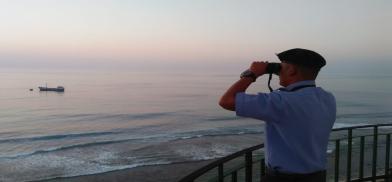India’s coastal security challenge - and preventing another 26/11
While this exercise was a long overdue and necessary measure, the whole gamut of India’s coastal security in view of terrorist threats and other crimes must function effectively and consistently as there have been instances of breaches in coastal security after 26/11

On July 20, 2022, Mumbai Police received a threat about a repeat of the 26/11/2008 attack on Mumbai. This is because Pakistan’s Inter-Services Intelligence (ISI)-terrorist combo have been quite frustrated with their continuous attempts in Jammu and Kashmir being neutralised by the Indian Army and its security forces.
Having written extensively about circumstances related to the 26/11 attack, in January 2019 this writer wrote an article titled ‘10 years after 26/11 attack: Is India’s maritime, coastal security any better?’. It was published in The Asian Age, Deccan Chronicle and other publications, recalling the heinous 26 November 2008 attack on Mumbai by terrorists of Pakistan’s Lashkar-e-Tayyaba, who came by the sea route without being detected.
In the process, they exposed many weaknesses and lacunae in India’s coastal security. The attack shook the government into realizing the urgent need to greatly tighten the security of India’s long coastline of 7,600 km, including its island territories and 2,000,000 square km of Exclusive Economic Zone.
Post 2008
In 2008, the then Home Minister was changed and a beginning was made by the ministries of defence and home affairs to discuss and decide on long overdue raising and enhancing coastal police, providing them equipment, stepping up coastal patrolling, joint tactical exercises and multi-dimensional expeditions to explore and familiarize the armed forces personnel with stretches of India’s vast seaboard.
In February 2009, the government had designated the Indian Navy as the authority responsible for overall maritime security, which includes coastal and offshore security, assisted by the Indian Coast Guard (ICG), state marine police forces and other central and state agencies.
The ICG was additionally designated as the authority responsible for coastal security in territorial waters including areas to be patrolled by the coastal police. Further, to ensure that assets are optimally deployed and there is synergy between the two organizations, the Navy was assigned to control all Navy and Coast Guard joint operations.
Coastal security
Coastal security is complex construct since it involves activities both at sea and at land. The targets of the terrorists could be well inland. In the aftermath of 26/11, a holistic government approach to maritime security was adopted and a large number of measures were taken by a host of stakeholders.
The National Committee on Strengthening Maritime and Coastal Security (NCSMCS) with the Cabinet Secretary at the helm was set up to review important matters pertaining to coastal security and for effective centre-state coordination. The same committees were established at state and district levels. Also, joint operations centres (JOCs) of the Navy and coastal security operation centres of the Indian Coast Guard came up.
A multi-tier patrol and surveillance mechanism with focus on technical surveillance and augmenting maritime domain awareness (MDA) through the coastal radar chain and other systems was adopted. Real-time information sharing through the national command, control, communication and intelligence (NC3I) network; greater intelligence and operational coordination were made the focus areas. Security initiatives were initiated in fisheries, offshore, ports and shipping sectors.
However, apart from the Navy and the Coast Guard, implementation of the multifarious actions involved by other ministries and departments was slow or incomplete.
Coastal defence exercise
Ten years after 26/11, the Indian Navy coordinated the largest-ever coastal defence exercise off the Indian coast on January 22-23, 2019, codenamed Sea Vigil. The first ever of its kind, this exercise was undertaken along the entire 7,516.6 km coastline and India’s EEZ involving all nine coastal states and four union territories along with all maritime stakeholders and facilitated by the ministries of defence, home affairs, shipping, petroleum and natural gas, fisheries, customs, state governments and other agencies of the centre and state as well as the fishing and coastal communities.
The scale of the exercise was unprecedented in terms of the geographical extent, the number of stakeholders involved, the number of units deployed, and in terms of the objectives to be met.
Planned in two phases, Phase I commenced with the deployment of personnel and seagoing units of all stakeholders. A total of 150 ships and 35 aircraft of the Navy and Coast Guard were deployed for the exercise. This, when added to sea-going assets of other stakeholders like the state police, Central Industrial Security Force (CISF) and Customs, reached an astonishing 500-600 craft at sea. This layered defence provided almost unbroken surveillance along the entire coast of India and outlying islands.
This was further enhanced by the chain of radar stations set up along the coast as part of the coastal surveillance network (post 26/11, all 46 lighthouses along India’s coastline are radar stations). All this was fed back to the JOCs set up by the Navy at Mumbai, Kochi, Visakhapatnam and Port Blair for monitoring, analysis and response. The uniform and technical surveillance network was further augmented by the fishing communities along the coast as the “eyes and ears” of the nation’s coastal security construct.
Dummy incursions
Phase I also saw an intensive audit of all measures put in place since 26/11 to improve the measures of efficiency and effectiveness of coastal security. This was undertaken by multi-agency teams deployed to check and audit important landing points including fish landing centres, vulnerable areas and important installations along the coast as well as in the hinterland.
The entire coastal security apparatus was thereafter shifted to Phase II commencing at 8 p.m. on January 22. This phase saw attempts to penetrate and land dummy explosives by designated “RED” forces comprising teams drawn from the Navy, Coast Guard, police and Central Industrial Security Force.
These teams were given a free hand to commandeer fishing vessels and merchantmen and attempt to reach the coast. Around 8-10 teams were deployed in each state. It is to the credit of all participating agencies that only a few “attacks” were successful. Many attacks were allowed to “go through” to test the robustness of police checkpoints which were found to be very effective throughout the exercise. The customs department also undertook rummaging of visiting ships at anchorage and in harbours.
Phase II involved the exercising of various contingencies on land after an “assumed landing”.
The National Security Guard was also called in to tackle hostage situations in two-three vital installations. Contingencies including hijacking of ships, bomb disposal in malls, attacks and responses on places of worship were also exercised and tested for effectiveness. Crisis management groups of states were also activated to deal with such situations.
Breaches have happened
This first and largest ever in scale and extent coastal defence exercise was to be institutionalised and conducted every alternate year in addition to the states-focussed Sagar Kavach series of exercises. Also, Ex Sea Vigil was a build-up towards the major theatre level tri-service exercise TROPEX (Theatre-level Readiness Operational Exercise) which the Indian Navy conducts every alternate year.
While this exercise was long overdue and necessary measure, the whole gamut of India’s coastal security in view of terrorist threats and other crimes must function effectively and consistently as there have been instances of breaches in coastal security after 26/11.
In 2011, two years after 26/11, reportedly three massive vessels entered Mumbai which included a container ship named MV Wisdom, loaded with 7,025 tonnes of deadweight, and MV Pravit containing 1,000 tonnes of materials, which escaped the huge set-up of surveillance. In the latter case, the information of the drifting was given by fishermen, but the response was received only after 14 hours.
These are merely some examples. Although so many items of security infrastructure are in place, there is a discrepancy in their use. Patrol boats are under-utilized, there is a shortage of manpower and huge amount of funds remain unspent. The lack of integration of the marine police in the system is also a root cause of the problem.
Pakistani terror
The NCSMCS, which coordinates the coastal security activities of the maritime agencies, is reportedly merely an ad hoc arrangement, which has not been backed by the enactment of the Coastal Security Bill. There have been some disagreements in the functioning of the surveillance systems. While the security agencies have preferred active tracking of individual fishing boats through onboard transponders for e-surveillance, the state maritime board officials seek a satellite tracking system.
When a Coast Guard team during a security exercise some years ago enacted the entry of the 26/11 Pakistani terrorists from the sea opposite Badhwar Park, it succeeded – that is, they entered and proceeded ahead undetected and unchallenged.
Any lacunae or drawbacks still persisting in the coastal security system must urgently be rectified in order to avoid a repeat the 26/11 in any part of India. And that possibility cannot and must not be ruled out, all the more so because of the frustration and desperation of Pakistan’s anti-India agencies which have faced great reverses in Jammu and Kashmir.
The Indian government’s response to the 26/11 attack was nothing short of pathetic. In 2016, Indian Army’s surgical strikes and later Indian Air Force’s precision air attack over Balakot were appropriate responses but only once each. If there is any 26/11 kind of attack by Pakistani terrorists as threatened, whether it succeeds or not, concerted and sustained targeting must be done on Pakistan’s terrorist camps and concentrations and terrorist leaders.
It is quite clear that random anti-terrorist strike by Indian forces are certainly not enough. In any case repeated effective strikes against Pakistani terrorist groups are overdue in view of their sustained attacks on not only against the Army and security forces but also against Kashmiri Pandits and Hindus trying to resettle in the Kashmir Valley with a view to creating a fear psychosis.
(The author is a former spokesman of the Ministry of Defence and Indian Army. Views are personal)










Post a Comment